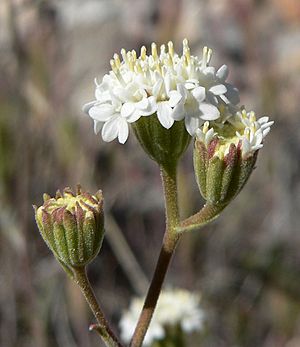Chaenactis stevioides facts for kids
Quick facts for kids Chaenactis stevioides |
|
|---|---|
 |
|
| Scientific classification | |
| Kingdom: | |
| (unranked): | |
| (unranked): | |
| (unranked): | |
| Order: | |
| Family: | |
| Tribe: | |
| Genus: | |
| Species: |
C. stevioides
|
| Binomial name | |
| Chaenactis stevioides Hook. & Arn.
|
|
Chaenactis stevioides, also known as Esteve's pincushion or desert pincushion, is a beautiful flowering plant. It belongs to the daisy family. This plant is known for its unique flowers that look a bit like pincushions.
Where It Grows
Esteve's pincushion grows naturally in parts of the United States and Mexico. You can find it in dry, open areas like deserts. It is very common in the Mojave Desert and the southern Great Basin during springtime. It also grows in the chaparral and woodland areas of southern California. This plant loves sunny, arid places.
What It Looks Like
Esteve's pincushion is an annual plant. This means it grows from a seed, flowers, and dies within one year. It usually has one or more straight stems. These stems can grow up to about 45 centimeters (18 inches) tall. When the plant is young, its stems are covered in fine, cobweb-like hairs. These hairs become less noticeable as the plant gets older.
The leaves of the plant are about 2 to 4 centimeters (0.8 to 1.6 inches) long. They are divided into many small, detailed sections.
At the top of a tall stalk, you will find several flower heads. Each flower head has stiff, hairy leaves called phyllaries around its base. Inside, there are many small flowers. These flowers can be white, pink, or pale yellow. The flowers around the edges of the head are larger and more open. The ones in the center are smaller and shaped like tiny tubes. After the flowers bloom, the plant produces small fruits called achenes. Each achene has a feathery top called a pappus.

